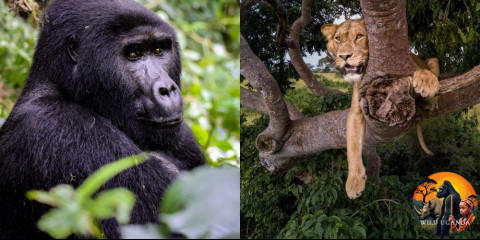Tour Length
Rates in USD $ – Change Currency
Per person, excl. international flightsOperator Rating
Other Tour Features
Filter by Operator
Filter by Accommodation
Kalinzu Chimpanzee Trekking Tours
Sharing a western border with Queen Elizabeth National Park, the 141km²/54mi² Kalinzu Forest Reserve protects a tropical rainforest that rises from the Rift Valley floor to the Kichwamba Escarpment. More than 300 chimps roam wild in this pristine jungle, and two communities have been habituated, one for research purposes and the other for tourist visits. Kalinzu is less publicized than other chimp-watching venues, but it is emerging as a popular addition to budget safari tours, thanks to its combination of low prices, ready accessibility and high success rate. Like chimp trekking elsewhere, visiting these humanlike apes (with which we humans share almost 99% of our DNA) in Kalinzu is pure magic and utterly unforgettable.
-
Best Seller

10-Day Gorilla, Chimpanzee & Big 5 Game Safari in Uganda
$3,410 pp (USD)
Uganda: Private tour
Mid-range Lodge & Guest HouseYou Visit: Entebbe (Start), Mabamba Swamp, Ziwa Rhino Ranch, Murchison Falls NP, Kibale NP (Chimps), Kalinzu FR (Chimps), Ishasha Sector (Queen Elizabeth NP), Bwindi Impenetrable NP (Gorillas), Lake Bunyonyi, Lake Mburo NP, Entebbe (End)

Wild Uganda
5.0/5 – 29 Reviews
-

3-Day Exciting Queen Elizabeth National Park Safari
$682 pp (USD)
Uganda: Private tour
Mid-range LodgeYou Visit: Entebbe (Start), Queen Elizabeth NP, Kalinzu FR (Chimps), Entebbe (End)

Dav Safaris
5.0/5 – 166 Reviews
-

3-Day Express Gorilla and Chimpanzee Tour
$1,920 pp (USD)
Rwanda & Uganda: Private tour
Mid-range LodgeYou Visit: Kigali (Start), Queen Elizabeth NP, Kalinzu FR (Chimps), Bwindi Impenetrable NP (Gorillas), Kigali (End)

Safari Vacations and Travel Services
5.0/5 – 35 Reviews
-

4-Day Cultural Experience, Volunteering & Wildlife Tour
$1,810 pp (USD)
Rwanda & Uganda: Shared tour (max 14 people per vehicle)
Mid-range Lodge & ResortYou Visit: Kigali (Start), Lake Bunyonyi, Lake Mburo NP, Queen Elizabeth NP, Kalinzu FR (Chimps), Kigali (End)

Amatsiko Tours
5.0/5 – 11 Reviews
-
![7-Day Gorillas, Chimpanzee and Wildlife Encounter]()
7-Day Gorillas, Chimpanzee and Wildlife Encounter
$2,915 pp (USD)
Uganda: Private tour
Mid-range Lodge & ResortYou Visit: Entebbe (Start), Murchison Falls NP, Queen Elizabeth NP, Kalinzu FR (Chimps), Bwindi Impenetrable NP (Gorillas), Lake Bunyonyi, Entebbe Airport (End)

Kajie Safaris
5.0/5 – 176 Reviews
-
![4-Day Bwindi, Lake Bunyonyi & Kalinzu Forest Chimps]()
4-Day Bwindi, Lake Bunyonyi & Kalinzu Forest Chimps
$1,544 pp (USD)
Rwanda & Uganda: Private tourBudgetLodge & Hotel
You Visit: Kigali (Start), Bwindi Impenetrable NP (Gorillas), Lake Bunyonyi, Kalinzu FR (Chimps), Kigali (End)

Roads of Adventure Safaris
4.9/5 – 7 Reviews
-
![6-Day Uganda Honeymoon Safari]()
6-Day Uganda Honeymoon Safari
$2,805 pp (USD)
Uganda: Private tour
Mid-range Lodge & BandaYou Visit: Entebbe (Start), Queen Elizabeth NP, Kalinzu FR (Chimps), Bwindi Impenetrable NP (Gorillas), Entebbe Airport (End)

Ibanga Expeditions
5.0/5 – 13 Reviews
-
![4-Day Gorillas, Game Drive and Chimpanzee at Kalinzu]()
4-Day Gorillas, Game Drive and Chimpanzee at Kalinzu
$2,695 pp (USD)
Rwanda & Uganda: Private tour
Mid-range LodgeYou Visit: Kigali (Start), Bwindi Impenetrable NP (Gorillas), Queen Elizabeth NP, Kalinzu FR (Chimps), Kigali (End)

Gorilla Explorers
5.0/5 – 2 Reviews
-
Best Seller
![3-Day Gorilla and Chimpanzee Trekking Safari]()
3-Day Gorilla and Chimpanzee Trekking Safari
$1,601 pp (USD)
Uganda: Private tourBudgetLodge
You Visit: Entebbe (Start), Bwindi Impenetrable NP (Gorillas), Kalinzu FR (Chimps), Entebbe Airport (End)

Giant Holiday Safaris
5.0/5 – 7 Reviews
-
![3-Day Queen Elizabeth and Chimpanzee Trekking]()
3-Day Queen Elizabeth and Chimpanzee Trekking
$662 pp (USD)
Rwanda & Uganda: Shared tour (max 8 people per vehicle)
Mid-range LodgeYou Visit: Kigali (Start), Queen Elizabeth NP, Kalinzu FR (Chimps), Genocide Memorial (Kigali), Kigali (End)

We Tour Africa Safaris
5.0/5 – 4 Reviews
-
![6-Day Game Viewing, Primates and Lake Bunyonyi Safari]()
6-Day Game Viewing, Primates and Lake Bunyonyi Safari
$2,707 pp (USD)
Uganda: Private tourBudgetLodge & Resort
You Visit: Entebbe (Start), Queen Elizabeth NP, Kalinzu FR (Chimps), Bwindi Impenetrable NP (Gorillas), Lake Bunyonyi, Entebbe Airport (End)

Green and Yellow Tours
5.0/5 – 2 Reviews
-
![11-Day Queen, Bwindi, Serengeti & Ngorongoro Crater Rim]()
11-Day Queen, Bwindi, Serengeti & Ngorongoro Crater Rim
$4,798 pp (USD)
Tanzania & Uganda: Private tour
Mid-range Lodge & Tented CampYou Visit: Entebbe (Start), Entebbe Airport (Entebbe), Queen Elizabeth NP, Kalinzu FR (Chimps), Ishasha Sector (Queen Elizabeth NP), Bwindi Impenetrable NP (Gorillas), Lake Bunyonyi, Kilimanjaro Airport, Serengeti NP, Central Serengeti NP, Ngorongoro Crater, Mto wa Mbu (Town), Moshi (End)

Safari Retreats Africa
5.0/5 – 11 Reviews
-
![6-Day Rwanda Uganda Gorilla Trekking & Chimpanzee Safari]()
6-Day Rwanda Uganda Gorilla Trekking & Chimpanzee Safari
$2,697 pp (USD)
Rwanda & Uganda: Private tour
Mid-range Lodge & ResortYou Visit: Kigali (Start), Genocide Memorial (Kigali), Volcanoes NP (Gorillas), Bwindi Impenetrable NP (Gorillas), Queen Elizabeth NP, Kalinzu FR (Chimps), Lake Bunyonyi, Kigali (End)

Valverde Safaris
5.0/5 – 7 Reviews
-
![5-Day Gorillas, Chimps and Tree-Climbing Lions]()
5-Day Gorillas, Chimps and Tree-Climbing Lions
$2,089 pp (USD)
Uganda: Private tour
Mid-range Lodge & Guest HouseYou Visit: Entebbe (Start), Queen Elizabeth NP, Kalinzu FR (Chimps), Ishasha Sector (Queen Elizabeth NP), Bwindi Impenetrable NP (Gorillas), Lake Bunyonyi, Entebbe (End)

Wild Uganda
5.0/5 – 29 Reviews
-
![5-Day Gorilla, Lions and Chimpanzee Tracking at Kalinzu]()
5-Day Gorilla, Lions and Chimpanzee Tracking at Kalinzu
$3,080 pp (USD)
Rwanda & Uganda: Private tour
Mid-range Lodge & BandaYou Visit: Kigali (Start), Bwindi Impenetrable NP (Gorillas), Queen Elizabeth NP, Kazinga Channel (Queen Elizabeth NP), Kalinzu FR (Chimps), Kigali (End)

Gorilla Explorers
5.0/5 – 2 Reviews
-
![7-Day Best Uganda Safari Holiday, True Escape]()
7-Day Best Uganda Safari Holiday, True Escape
$2,343 pp (USD)
Uganda: Private tour
Mid-range Lodge & HotelYou Visit: Entebbe (Start), Ziwa Rhino Ranch, Murchison Falls NP, Queen Elizabeth NP, Kalinzu FR (Chimps), Bwindi Impenetrable NP (Gorillas), Lake Bunyonyi, Entebbe (End)

Roads of Adventure Safaris
4.9/5 – 7 Reviews
-
![4-Day Gorilla, Golden Monkey & Chimps Safari Adventure]()
4-Day Gorilla, Golden Monkey & Chimps Safari Adventure
$1,947 pp (USD)
Uganda: Private tour
Mid-range Lodge & HotelYou Visit: Entebbe (Start), Bwindi Impenetrable NP (Gorillas), Mgahinga Gorilla NP (Gorillas), Kalinzu FR (Chimps), Entebbe Airport (End)

Giant Holiday Safaris
5.0/5 – 7 Reviews
-
![5-Day Gorillas, Golden Monkeys, Chimps & Wildlife Epic]()
5-Day Gorillas, Golden Monkeys, Chimps & Wildlife Epic
$2,584 pp (USD)
Rwanda & Uganda: Private tour
Mid-range Lodge & HotelYou Visit: Kigali (Start), Volcanoes NP (Gorillas), Bwindi Impenetrable NP (Gorillas), Kalinzu FR (Chimps), Queen Elizabeth NP, Kigali (End)

Ibanga Expeditions
5.0/5 – 13 Reviews
-
![7-Day Bwindi, Murchison, Queen Elizabeth, Lake Bunyonyi]()
7-Day Bwindi, Murchison, Queen Elizabeth, Lake Bunyonyi
$3,410 to $3,960 pp (USD)
Uganda: Private tour
Mid-range Lodge & ResortYou Visit: Entebbe (Start), Ziwa Rhino Ranch, Murchison Falls NP, Queen Elizabeth NP, Kalinzu FR (Chimps), Bwindi Impenetrable NP (Gorillas), Lake Bunyonyi, Entebbe (End)

Wild Uganda
5.0/5 – 29 Reviews
-
![9-Day Gorillas, Golden Monkey, Hiking, Wildlife & Chimp]()
9-Day Gorillas, Golden Monkey, Hiking, Wildlife & Chimp
$4,619 pp (USD)
Rwanda & Uganda: Private tour
Mid-range Lodge & ResortYou Visit: Kigali (Start), Kisoro (Town), Mgahinga Gorilla NP (Gorillas), Bwindi Impenetrable NP (Gorillas), Ishasha Sector (Queen Elizabeth NP), Queen Elizabeth NP, Kalinzu FR (Chimps), Lake Bunyonyi, Genocide Memorial (Kigali), Kigali (End)

Gorilla Explorers
5.0/5 – 2 Reviews
7 Questions About Kalinzu Chimpanzee Trekking Tours

Answered by
Philip Briggs
Philip is an Africa-specialized travel writer who first visited Uganda in 1988 and has returned regularly to research his Bradt Guide to Uganda (now in its 10th edition). He has tracked chimps in Uganda and elsewhere in East Africa on at least two dozen occasions.› More about Philip
7 Questions About Kalinzu Chimpanzee Trekking Tours
 Philip Briggs
Philip Briggs
How does chimp trekking in Kalinzu Forest compare to other chimp trekking reserves in Uganda?
“Kalinzu ranks among the best places to track chimps in Uganda. The success rate stands at above 90%. This is lower than Kibale National Park, but comparable to or better than other Ugandan chimp trekking sites such as Kyambura Gorge (which also borders Queen Elizabeth National Park), Budongo Forest and Toro-Semliki Wildlife Reserve. Three major advantages of doing a chimp trek at Kalinzu are that permits are much cheaper than elsewhere (you could track chimps here twice for half the cost of a single permit at Kibale), that it is relatively uncrowded, and that it is highly accessible to independent travelers whether they self-drive or use public transport. We also like the fact that chimp trekking and other activities in Kalinzu form part of a community-based ecotourism project, which is managed in conjunction with the National Forestry Authority. A disadvantage of tracking at Kalinzu is that the hike out to locate the chimps is generally relatively long and demanding, but this should not be a deterrent to a moderately fit traveler.”
1Is chimp trekking in Kalinzu easily incorporated in a general Uganda trip?
“Absolutely. Nearby Queen Elizabeth National Park is included on most Uganda tour packages, and Kalinzu can easily be visited as a day trip from most camps there. Kalinzu is also the closest chimp trekking venue to Bwindi Impenetrable National Park, Uganda’s main gorilla trekking destination. Furthermore, Kalinzu’s reception office and trekking trailhead are set right alongside a busy surfaced main road. It is very accessible to independent travelers, whether they are on a self-drive holiday or use public transport.”
2Are chimp sightings guaranteed?
“Chimp sightings are not guaranteed anywhere in Uganda, and Kalinzu is no exception. This is because, unlike gorillas, chimpanzees are very restless and often move long distances at a rapid pace or sit high in the canopy obscured by foliage. Within that context, however, Kalinzu’s recent success rate of 90% is about as good as it gets outside Kibale National Park, the country’s premier chimp-watching venue. And the lower permit price means that you could consider a second trek (and even a third or fourth) should the first attempt be unsuccessful.”
3Are mornings or afternoons best for chimp trekking?
“This can vary considerably from one day to the next, but the morning chimp trek (which leaves from the reception office at 8 AM) typically offers the best sightings. This is partly because chimps are more active and vocal in the morning, so they tend to be easier to locate and to see clearly. But it’s also because you can stay out longer if required without having to worry about returning in the dark. That said, if the afternoon trek (which leaves at 3 PM) slots in better with your trip itinerary, it is also often very productive, so worth doing.”
4What fitness level is required?
“Chimp trekking in Kalinzu tends to be slightly harder work than it is in Kibale National Park or Budongo Forest, as you need to walk farther and the terrain is more hilly. But even so, the level of fitness required is moderate. If you are reasonably agile and comfortable with the idea of spending around four hours on your feet, you should be fine. If that sounds daunting, however, then you might want to do some light training before you travel.”
5What other animals live in Kalinzu Forest?
“A wide diversity of mammals, birds and other creatures live in Kalinzu. Chimps aside, five primates that are active by day are regularly seen in the forest. These are olive baboon, black-and-white colobus, blue monkey, red-tailed monkey and L’Hoest’s monkey. Kalinzu is also an important refuge for the rare pygmy antelope, while elephant, buffalo, leopard and even lion occasionally stray across from Queen Elizabeth National Park. A bird checklist of 378 species features an impressive selection of striking forest specialists including great blue turaco, black-and-white-casqued hornbill and black bee-eater.”
6Is chimp trekking in Kalinzu Forest safe?
“Yes. Although male chimps are heavier and stronger than human adults, the habituated community here is very relaxed around people. While you are in the forest, there is a chance of bumping into the likes of elephant and buffalo, but this is a very rare occurrence. And when it does happen, the animal will normally move on. Prior to your chimp trek, an experienced guide will brief you about safety. If you follow their instructions, you have little to worry about. Note, however, that for safety reasons, children under the age of 12 are not allowed to track chimpanzees.”
7























